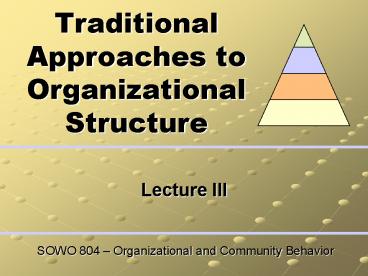Traditional Approaches to Organizational Structure - PowerPoint PPT Presentation
1 / 17
Title:
Traditional Approaches to Organizational Structure
Description:
Traditional Approaches to Organizational Structure Lecture III SOWO 804 Organizational and Community Behavior – PowerPoint PPT presentation
Number of Views:191
Avg rating:3.0/5.0
Title: Traditional Approaches to Organizational Structure
1
Traditional Approaches to Organizational Structure
- Lecture III
SOWO 804 Organizational and Community Behavior
2
Traditional Response to Katrina
- Direct Practice and Macro Practice responses
helping people on an individual and community
level - Role of Cultural Competence?
- Should Organizations Change with the Times? If
yes, When, How? - Can past Organizational responses suffice if
rooted in successful social work practices?
3
What is an Organization?
- A Holistic View
- Organizations are Holistic
- Organizations are Ecological
- Organizations are Organic
- Organizations are People-Based
(Holistic Model, n.d.)
4
An Organizations Mission
- The Threefold Mission
- Develop and Implement all the Parts
- Connect the Parts Cause and Effect
Relationships Understood - Coach the People
(Holistic Model, n.d.)
5
Mission, Vision and Values
(Holistic Model, n.d.)
6
The Four Organizational Forms
- Explicate Order vs. Implicate Order
- Explicate Order
- It manifest structure associated with power,
hierarchy of task, and roles - Implicate Order
- These organizations are defined by social
associations, empathetic/creative
interrelationships, feeling fields, metaphors and
symbols - Models
- Community Building Model
- T-group Model
- Other Environments that function with Implicate
Order - Creative Environments
- Expressive Arts
- Improvisational Jazz
- Pedagogy of the Oppressed (P. Friere) - Model of
Education
(Dinkelaker, 1997)
7
4 Types of Organizations
- Bureaucratic
- Matrix (Research and Development)
- Familial Organization
- Organic Adaptive
(Dinkelaker, 1997)
8
Organizational Structure and Design
- Organizational Structure describes the
organizations framework as expressed by its
degree of complexity, formalization, and
centralization - Complexity How is the Work Divided?
- Formalization - The Rules of Employee Behavior
- Centralization Who at the TOP is Making
Decisions? - Decentralization Is Decision Making Occurring
In Lower Levels of the Organization?
(Organization Structure, n.d.)
9
Organizational Structure and Design (Contd)
- Organizational Design
- Six Elements
- Work specialization
- Departmentalization
- Chain of command
- Span of control
- Centralization/Decentralization
- Formalization
- Classical View vs. Contemporary View
- Unity of Command
- Authority and Responsibility
- Span of Control
(Organization Structure, n.d.)
10
Organizational Structure and Design (contd)
- Horizontal Dimensions
- Division of Labor
- Departmentalization
- Functional
- Product
- Customer
- Geographic
- Process
(Organization Structure, n.d.)
11
Importance of Environment
- Environment Greatly Influences How Organizations
Form, Structure, and Function
C
People
Systems and Rules
Culture Community
Goals Objectives
The Agency
Work Structure
Technology
(Clifton, 1980)
12
Importance of Environment (contd)
- Organizations Response to Environmental
Influences were Especially Evident During the
20th Century
1900 1950 2000
- Early 1900s Largest Single Group Farmers,
Second Group Live-In Servants - Industrial Revolution Farmers and Live-In
Servants move to the cities, but remained
impoverished. - By 1950 Labor Unions made Industrial Workers
Middle Class Citizens - By 1990 Labor Unions in Retreat
- No Class in History has ever risen faster than
the blue-collar worker. And no class in history
has ever fallen faster. - Now The Rise of a Knowledge Society.
(Drucker, 1994)
13
Importance of Environment (contd)
- Environmental Influences on the 21st Century
Organization - Voicemail
- Facsimile Machines
- Teleconferencing
- Electronic Data Interchanges
- Intranets
- Telecommuting
- Virtual Workplaces
(Organization Structure, n.d.)
14
Group Activity
- Power-Oriented Agencies (The White House)
- Centralized Power - Power is held either by a
select number of key individuals or by one
person. - The organization's success or failure is
determined by the central power source. - This Power Source must be willing to take risks
in an effort to increase the agency's success. - Role-Oriented Agencies (DSS)
- Emphasize is on Role Relationships.
- Members work under the principles of logic,
rationality, and caution. - The roles of the individual members are clearly
defined in policies. - The focus of these agencies is on the
organization rather than the individuals who make
up the organization. - Task-Oriented Agencies (Boeing Aircraft)
- Emphasizes getting the job done by bringing
together resources and people. - The team concept makes this type of agency very
adaptive. Groups are formed for specific
purposes. - Group members have a high degree of control over
their own work. - Performance is determined by team results.
- People-Oriented Agencies (Human Resources
Consulting Firm) - Described as Single-cell organisms living in the
same solution but remaining independent of one
another.
(Clifton, 1980)
15
Activity Directions
- Choose one of your organizations to discuss
- Identify what type of agency is described
- Draw a Figure to demonstrate how this agency
functions - Identify 3 strengths of the agency
- Identify 3 barriers of the agency
16
A Quote to Remember
- Directors, coordinators, and staff members of
small community-based, social-service agencies
are realizing, in increasing numbers, that it is
they themselves who make their programs
effective. There will always be external
constraints and obstacles, but the people who
make up an agency must look inward for the
definition of rights, privileges, roles, and
responsibilities. - Kent Higgins
(Clifton, 1980)
17
References
- Cliton, Robert L, Dahms, Alan M. (1980)
Grassroots Administration, A handbook for Staff
and Directors of Small Community-Based Social
Agencies. Illinois Waveland Press, Inc. - Dinkelaker, A. (1997) The New Frontier in
Democratic Theory and Practice Organizational
Forms that Simultaneously Optimize Autonomy
Community. Retrieved September 8, 2003, from
http//quadrant4.org/thesis/chapter2.html - Drucker, P.F. (11/1994) The Age of Social
Transformation. Retrieved September 8, 2003 from
The Atlantic Monthly website http//www.theatlan
tic.com/politics/ecbig/soctrans.htm - A Holistic Model for Organizational Management.
(n.d.) Retrieved September 8, 2003 from
http//socialent.aztech-cs.com/resources/articles/
holistic/ - Organization Structure and Design. (n.d.)
Retrieved September 8, 2003 from
http//faculty.unitarklj1.edu.my/homepage/Coursewa
reWeb/bmb1013/LECTURE_NOTES?MODULE20IV/sec1.htm































